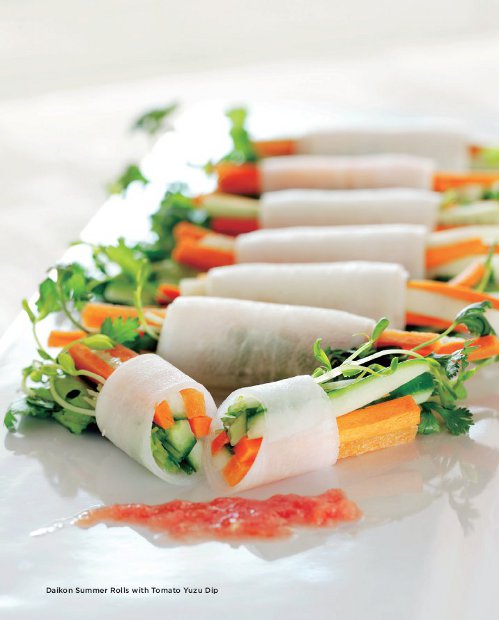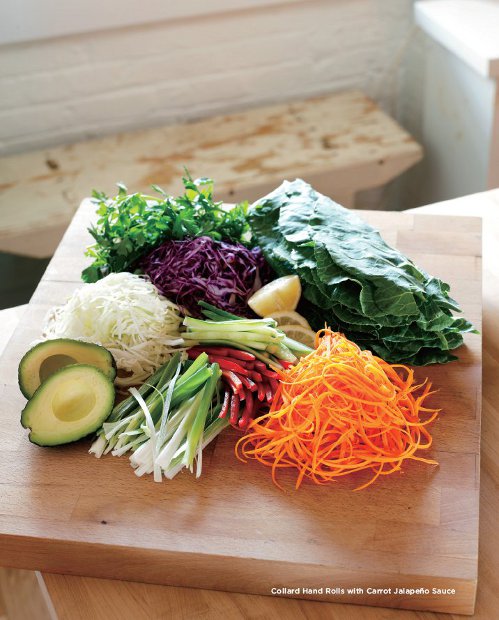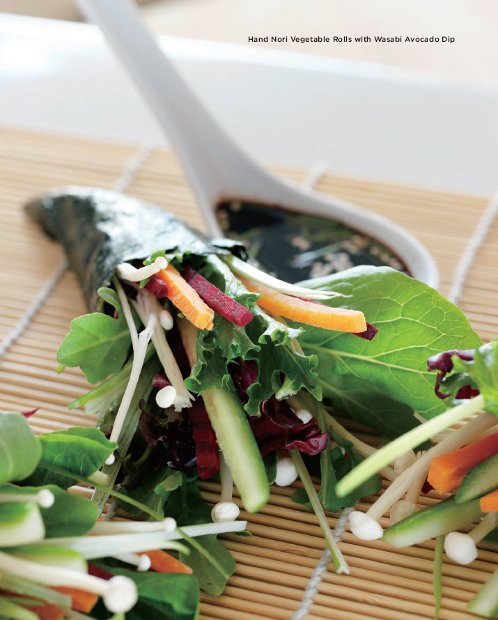
RAW WRAPS & ROLLS
I was enamored of raw wraps and rolls when I first starting experimenting with raw foods. Visually, they are so appealing, and creatively, there are no limits. For my more conventional private clients, I serve raw wraps and rolls as appetizers or as the first course before I move on to the rest of the menu. This is my way of introducing raw foods without preaching; they get their dose of fresh raw vegetables, and, more often than not, it is the most talked about part of their meal.
These preparations of raw vegetables burst with beauty and flavor. Representing the pinnacle of what can be achieved using raw vegetables, they are so light that you can eat your fill and not put on an ounce, and rich enough in leafy green vegetables that they fulfill your salad quota. Make extra wraps and rolls if you’re with others because they will be the most attractive and tasty items in the room and will quickly disappear.
—NATALIA
Daikon Summer Rolls with Tomato Yuzu Dip
Creating a thin, slightly transparent daikon sheet is pivotal to the success of this recipe. Too thin, it will fall apart; too thick, it will be cumbersome to roll. Persevere and the outcome will be worth it. These rolls are a refreshing crowd pleaser.
1 medium daikon radish
1 medium seedless cucumber, julienned
1 carrot, julienned
12 sprigs of cilantro
12 sprigs of mint
Tomato Yuzu Dip (see page 110)
To make daikon sheets, cut the daikon on each side to create a flat, even edge. Use a mandoline on the thinnest setting to make a dozen sheets. Roll each daikon sheet with several pieces of cucumber and carrot, a sprig of cilantro, and a mint leaf. Serve with Tomato Yuzu Dip on the side.
MAKES 12 ROLLS
Cucumber Avocado Roll
My go-to lunch back in my predetox days was a cucumber-avocado roll from my local Japanese market with a pint of miso soup. That was as healthy as it got for me. I patted myself on the back for ignoring the katsudon (fried pork cutlet and egg over rice). Who would have thought I would create a satisfying all-vegetable, no-starch alternative?
2 medium seedless cucumbers with skins
1 small carrot, shredded
1 avocado, chopped
Handful of alfalfa sprouts
1 nori sheet, chopped into thin strips (optional)
2 tablespoons nama shoyu
1 teaspoon wasabi paste
To make cucumber ribbons, trim the ends of each cucumber and use an upright vegetable peeler (for wider ribbons) or a mandoline on the thinnest setting. The ribbons should be very thin and slightly transparent.
Stack up two cucumber ribbons at a time, and using your finger as a guide, roll them into 1-inch circles. Stand each circle upright and lay the inside layer flat to seal the bottom hole.
Fill each cucumber roll with a layer of shredded carrots, add some diced avocado, and then top with sprouts and nori if using. Serve with nama shoyu and wasabi paste on the side.
MAKES ABOUT 12 ROLLS
Collard Hand Rolls with Carrot Jalapeño Sauce
I should call this the “kitchen sink” roll because I make this when I have leftover bits and ends of vegetables that didn’t make it into my juicer. Use this recipe as a general guide, but basically a handful of salad greens and a bunch of crunchy vegetables will do. Also, hand rolls don’t need to be rolled so neat and tight, so you can choose to blanch the collard greens or not.
3 collard leaves
2 cups field greens or shredded romaine lettuce
1 cup shredded red cabbage
1 cup shredded carrots
1 medium cucumber, julienned
1 cup mung bean sprouts
Handful of cilantro or parsley
Carrot Jalapeño Sauce (see page 111)
Cut the collard leaves from their center stems so you end up with 6 halves. Place a half leaf smooth side down, with the cut edge nearest you.
On the left side only, place a mound of greens and top with some of each of the remaining vegetables, letting them hang over the edges a bit.
To roll, bring the bottom left corner to the top right corner to create a triangle shape, and continue rolling until it forms a cone.
Repeat 3 steps above for all 6 rolls, then serve with sauce on the side.
MAKES 6 ROLLS

Thai Collard Rolls
The trick with this recipe is to blanch the collard greens, because it turns them a vibrant green and makes them easier to roll. To fill the rolls, you can use any crunchy vegetables you have on hand, including jicama, daikon, or even green papaya.
6 collard green leaves, blanched
1 cup shredded red cabbage
1 medium carrot, coarsely grated
1 cup Thai Guacamole (see page 102)
1 red bell pepper, cored and thinly sliced
2 scallions, halved lengthwise (white and green parts)
Handful of cilantro
To make collard wraps, remove the center stems and stack the leaves into a pile. Trim into 4 × 6-inch rectangles.
Dip collard greens in boiling water for less than 5 seconds and place in an ice-water bath. Dry with a clean kitchen towel.
On one end of the collard wrap, add a small mound of cabbage and carrot, a dollop of guacamole, and a couple pieces of red pepper, scallion, and cilantro.
Roll tightly into a thick cigarlike shape and cut down the middle on a diagonal. Place rolls seam side down on a plate.
MAKES 12 ROLLS
Hand Nori Vegetable Rolls with Wasabi Avocado Dip
This is another “kitchen sink” roll. Again, I’m not too particular about the vegetables, but raw fresh beets are a welcome addition.
3 nori sheets, halved into 6 smaller sheets
2 cups field greens
1 medium beet, julienned
1 medium carrot, julienned
1 medium cucumber, julienned
2 scallions, halved and sliced (white and green parts)
Wasabi Avocado Dressing (see page 110)
On the left side of a nori sheet, place a mound of greens and top with some of each of the remaining vegetables, letting them hang over the edges a bit. To roll, bring the bottom left corner to the top right corner to create a triangle shape, and continue rolling until it forms a cone. Repeat for all 6 rolls and serve with sauce on the side.
MAKES 6 ROLLS

Spicy “Tuna” and Avocado Sushi Roll
If you did your homework, you know that tuna and avocado do not combine well. I have very few recipes that aim to mimic dense food with vegetable substitutions, but this one warrants the mock tuna title. And, yeah, I also replace the rice with Jicama “Rice.”
2 red bell peppers, each pepper cored, seeded, and sliced into 4 equal pieces
1 tablespoon sriracha sauce
4 nori sheets
4 cups Jicama “Rice” (see page 95)
1 avocado, pitted, peeled, and sliced into thin strips
1 large cucumber, julienned
2 scallions, halved and sliced (white and green parts)
3 tablespoons nama shoyu
1 teaspoon wasabi paste
Lay the pepper pieces on a baking tray, skin side up, and place 2 inches from a broiler. Broil under high heat until the skin chars (about 10 minutes).
Transfer the peppers to a bowl, cover with a plate, and let cool before peeling off the skins. Slice into ¼-inch-thick strips and mix with the sriracha sauce.
Place a nori sheet on top of a sushi mat. Add 1 cup of Jicama “Rice” in an even layer on the lower half of the sheet. On the rice, add some avocado strips in a row and top with some spiced red pepper strips, cucumber, and scallions.
Start rolling the nori with the mat from the bottom half, tucking the rice inward. Keep using your mat to secure and tighten until you reach the top. Moisten the edge of the nori sheet with water to seal. Repeat steps 3 and 4 for all 4 nori rolls.
Cut each roll into 8 equal pieces, and serve with nama shoyu and wasabi paste on the side.
MAKES 4 ROLLS, 8 PIECES EACH
a note about sea vegetables
WHEN YOU USE HIJIKI, ARAME, OR ANY OTHER SEA VEGETABLES IN A RECIPE, IT IS IMPORTANT TO HYDRATE THEM FIRST. IF THEY ARE CONSUMED DRIED, THEY CAN HAVE A HARD TIME MOVING THROUGH THE BODY QUICKLY BECAUSE THEY SOAK UP THE BODY’S HYDRATION AND BECOME EXTREMELY BULKY. BEFORE ADDING SEA VEGETABLES TO A RECIPE, SIMPLY SOAK THEM IN A GLASS OF PURE WATER FOR 10 MINUTES AND DRAIN BEFORE USING. FOR NORI ROLLS, THIS IS NOT NECESSARY BECAUSE THEY BECOME QUITE HYDRATED BY THE CONTENTS OF THE WRAP. DULSE IS A SEASONING AND DOES NOT NEED TO BE SOAKED.